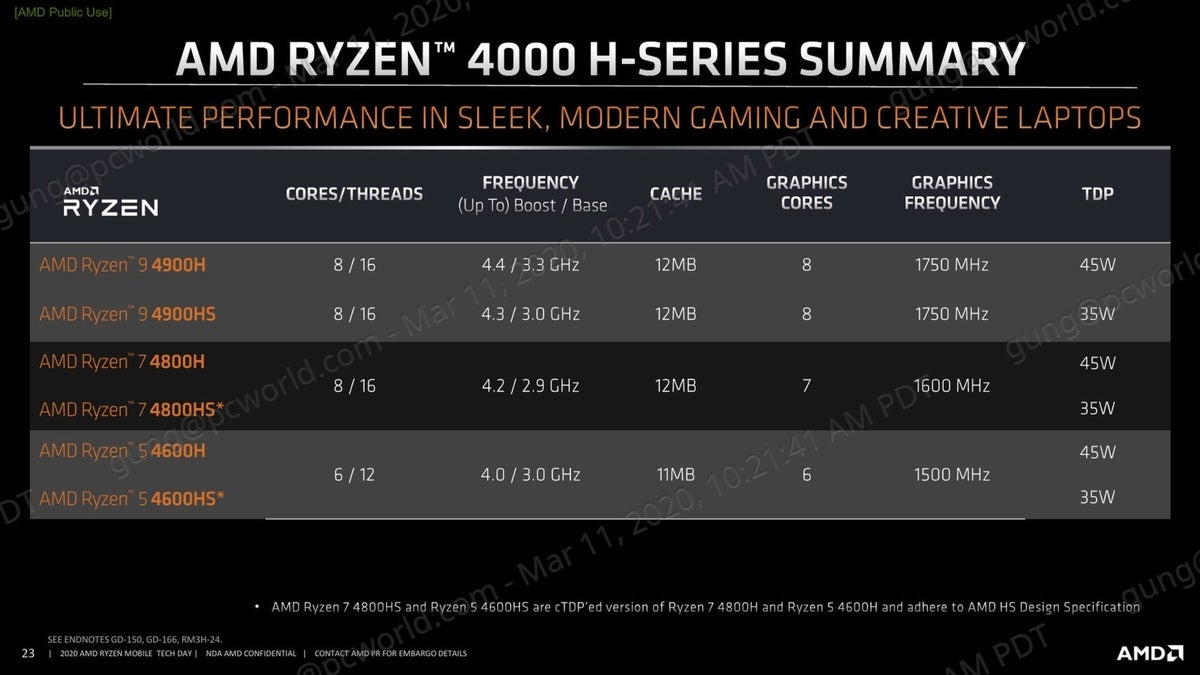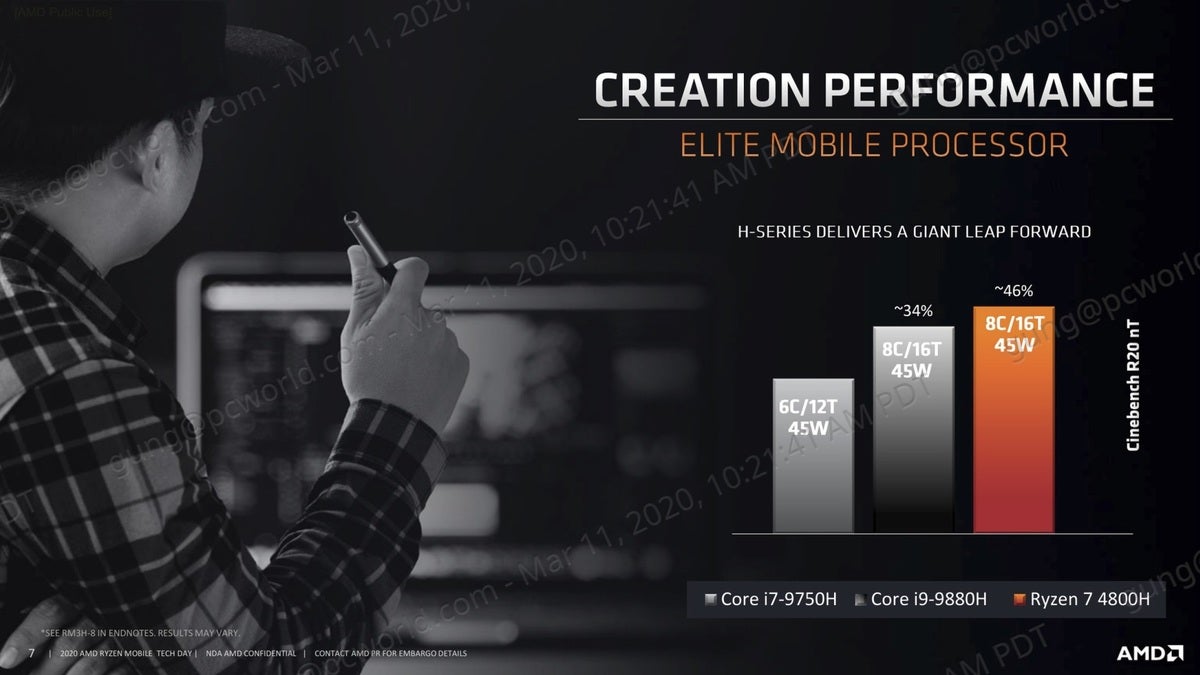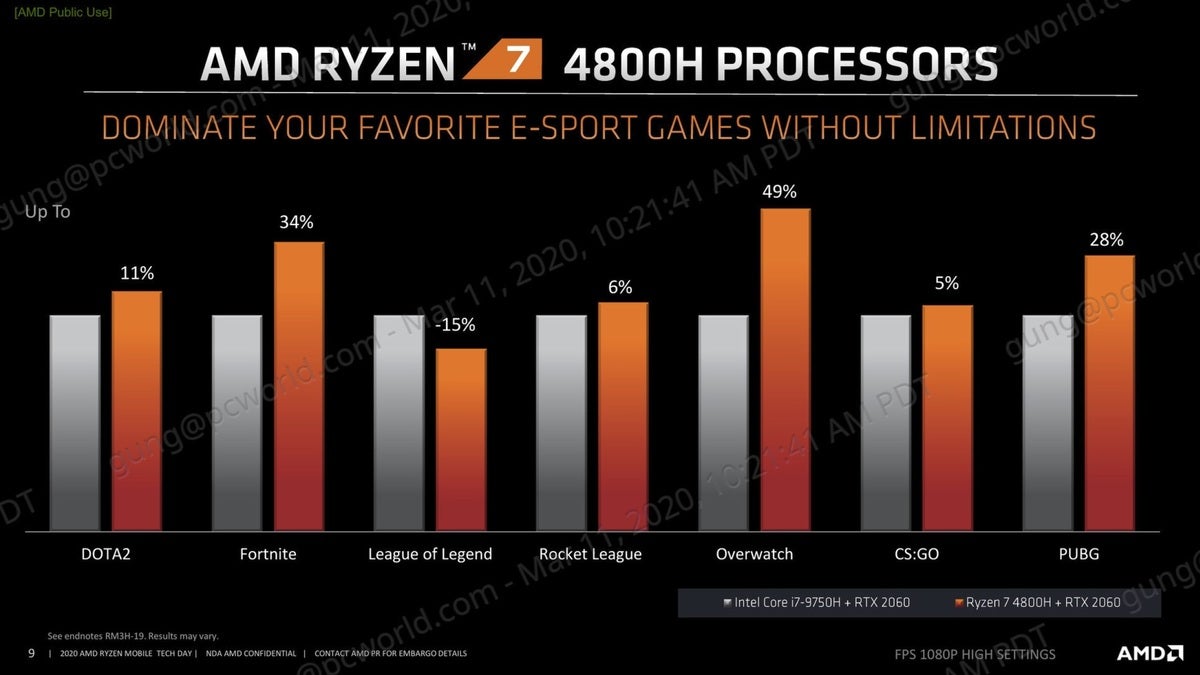AMD’s new Ryzen 9 laptop CPUs aim to topple Intel’s most powerful Core i9 chips
There’s bad news, and there’s real bad news for Intel if you believe AMD’s tests.
First, the bad news: AMD’s upcoming Ryzen 7 4000-series CPUs can outperform Intel’s Core i9 in multi-threaded tasks. The real bad news? AMD is also announcing two, even more potent Ryzen 9 4000 CPUs today:
- The 8-core, 16-thread Ryzen 9 4900HS is rated for a 35-watt TDP, with 12MB of cache. It will feature a base clock of 3GHz and a 4.3GHz boost clock, while its eight 7nm Radeon Vega graphics compute units will run at 1,750MHz.
- AMD’s fastest mobile chip to date, the 8-core, 16-thread Ryzen 9 4900H will feature a 3.3GHz base clock and a 4.4GHz boost clock at a rated 45 watt TDP. It’s otherwise identical to the HS version of the chip.
That brings AMD’s stable of full-power H-series chips and lower-power HS-series chips to a total of six for the Ryzen 4000 lineup, which you can see below.
 AMD
AMDAMD’s Ryzen 4000-series H and HS chips.
At CES, AMD had already crowed that its 8-core Ryzen 7 4800H multi-threaded performance would not only outpace Intel’s 6-core Core i7-9750H in laptops, but also a desktop 8-core Core i7-9700K. We pointed out that it was a bit facetious since the 9750H only packs six cores, while the 8-core 9700K doesn’t support Hyper-Threading. Well, now AMD said its Ryzen 7 4800H will also outperform Intel’s 8-core, 16-thread Core i9-9880H laptop chip.
 AMD
AMDAMD’s upcoming 8-core Ryzen 7 4800H will outperform both Intel’s 6-core Core i7-9750H and its 8-core Core i9-9880H, the company said.
And not by a little bit either. AMD said the Ryzen 9 4900HS is 28 percent faster than a Core i9-9880H in Cinebench R20, 23 percent faster in Handbrake encodes, 56 percent faster in Blender, and 32 percent faster in LAME. AMD admitted Intel still has an edge in sometests, however, with the Ryzen 9 having an 8 percent deficit in PCMark 10’s Digital Content Creation test.
The last result was a bit of a surprise, but it’s likely PCMark 10’s Digital Content Creation test—which is a blend of POV-Ray, FFMPEG video editing and ImageMagick photo editing—gives Intel the advantage due to the higher clock speeds on lighter tasks, as well as instruction set optimizations for Intel’s CPUs.
Is this comparison fair?
The Intel platform that AMD used for the comparison is likely also handcuffed by its form factor. AMD tested an MSI P75 Creator 9SF that features a 17-inch screen, discrete graphics, and the Core i9 chip. It’s also just 5 lbs., relatively thin, and also likely very constrained by thermals. We know from our experience testing numerous Core i9 laptops that the CPU can be extremely limited by the thermal performance of the notebook it’s housed in. A giant Acer Predator Helios 700, for example, easily out performs a Dell XPS 15 7590 even though both have the same CPU.
To that, we suspect AMD would say tough nuggies. Even though the P75 Creator is probably limited by its thermals, the laptop AMD used for its comparison is the upcoming Asus ROG Zephyrus G14, which weighs just 3.5 lbs and includes an Nvidia GeForce RTX 2060. One harsh reality that’s going to hurt Intel’s current Core i9 mobile CPU is you just can’t jam it into a laptop as thin and as light as a Ryzen 4000-based one and include a decently powerful GPU as well.
 AMD
AMDAMD’s low power Ryzen 9 4800HS outperforms Intel’s Core i9-9980H chip in many multi-threaded tasks but does give up ground in PCMark 10’s digital content creation benchmark.
Ryzen 7 4800H vs. Core i7-9750H: Gaming
AMD said the performance advantage for its high-powered Ryzen 4000 chips isn’t just in CPU-limited applications either. AMD claims it holds a gaming advantage over comparable Intel models—say, comparing a a Ryzen 7 4800H paired with a GeForce RTX 2060 against a Core i7-9750H paired with an RTX 2060 as well.
When comparing similar configurations in AAA games at 1080P, AMD had a slight advantage in most titles, but both were fairly close. That’s expected, as most triple-A games are heavily bottlenecked by the graphics card rather than the processor. Still, it’s a bit surprising that AMD’s claiming the lead in so many titles, as you can see in the chart below. AMD didn’t get into the how’s or why’s, but it’s possible that we’re seeing a total thermal advantage that Ryzen-based systems have over Core i9. We’ll have to wait for independent testing to see what’s up.
 AMD
AMDAMD’s Ryzen 4000 chip leads the way in many AAA games.
It’s not just AAA games either, but also in ultra-popular esports games. In everything but League of Legends, AMD claims a performance lead over a comparable Intel-based laptop.
 AMD
AMDAMD also does fairly well in many eSports-games too.
Ryzen 4000 HS design standard
Along with revealing the Ryzen 9 chips, AMD also detailed a little more about its new HS design standard. Originally thought to only be a lower power consumption version, AMD said for laptops to use the “HS” (for H-class Slim) designation, the laptops must also meet certain performance and thickness requirements. The poster child for HS is the Asus Zephyrus G14 referenced earlier, but AMD said it plans to grow the program as time goes on.
The HS design standard is somewhat similar to Nvidia’s Max-Q program, which really supercharged the thin gaming laptop movement.
Among the new 4000-series chips, the HS versions of Ryzen 7 and Ryzen 5 sport identical specifications as their normal H-series sibling, but tuned at 35 watts. Only the Ryzen 9 HS chip differs from the Ryzen 9 H in clock speed.





